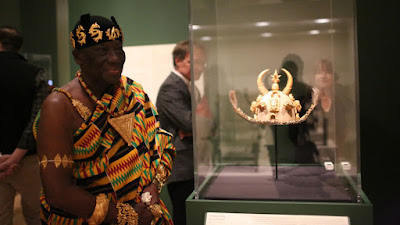 |
| Asante monarchy representation, ahead of the exhibition, in Dallas. |
Collections of Asante cultural objects from various museums in the U.S and Europe currently on display as 'The Power of Gold: Asante Royal Regalia from Ghana', at the Dallas Museum of Art through August 12 have received the nod of
The Asante king, His Majesty Otumfuo Osei Tutu II, Asantehene. NBC reports that the monarch sent his second-in-command to Dallas with a special message. “He is deeply appreciative of this special exhibition that has been mounted because gold is a symbol of the great Asantes and we are a proud nation within modern Ghana,” Daasebre Osei Bonsu II, Mamponghene was quoted as saying ahead of the opening.
The exhibition, said to feature over 250 objects, include pieces on loans from
Dallas Museum of Art’s collections, private collections and
several other museums including the British Museum and the Metropolitan Museum of Art.
“What is the power of gold? The power to acquire luxury items from wherever in the world, the power to impress. We are dazzled and bedazzled by the gold we see on him and it could be used to get some allies who strayed over this way to come back to the center,” Dr. Roslyn A. Walker, the museum’s Senior Curator of the Arts of Africa, the Americas, and the Pacific, and The Margaret McDermott Curator of African Art, said.
However, details provenance as regards the origin of the objects were not provided. The reports say the exhibition reflects the Asante kingdom’s participation in the gold trade with displays of gold weights, gold dust and evidence of cultural exchange with 14th century Egyptian brass vessels decorated with Arabic calligraphy.
Included are photographs of Asante living in the North Texas area, wearing Asante regalia.
“Most of the stools came out in the 19th century. You’ll notice they are various sizes. Some are for women, some are for rulers. They all have the same basic shape of a curved seat, a flat platform bottom and five supports,” Walker said. “The grander the stool, the more important the ruler.”
Perhaps the period that the objects "came out" as explained by the curator need to be expanded to include the origin.

No comments:
Post a Comment